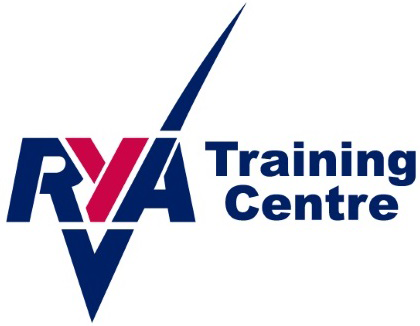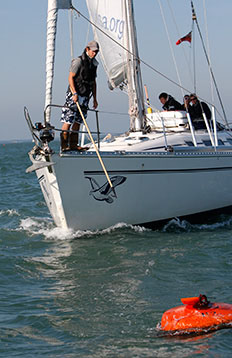
RYA Chief Instructor, Sail Cruising, Vaughan Marsh shares his top tips for picking up a mooring buoy under sail.
Last month we looked at picking up a buoy under motor, however sometimes your engine may not work or you decide you would like to sail onto the buoy just because it’s a nice thing to do. In this issue RYA Chief Instructor, Sail Cruising, Vaughan Marsh shares his top tips for picking up a mooring buoy under sail.
“The majority of the skills are the same however, at some stage you will need to have the vessel stopped at the buoy with the sails depowered. With some basic knowledge of sailing, a good appraisal and plan this is easily achievable and a satisfying skill to master”, commented Vaughan.
Let’s look at the stages in more detail – Appraise, Plan, Execute and Review.
Appraise
- Are you allowed to use the mooring?
An almanac, local chart or harbour master can help you - Is there enough depth for your vessel?
Are there any hazards to be aware of? - Which way to approach?
Look at how other vessels are lying to the buoys and position your boat at the same angle to your selected buoy. If there are no other boats to act as a guide, position your vessel down tide, or if there is no tide, downwind of the buoy. - Do a recce under sail.
Approach the buoy from a close hauled to beam reach position, pass the buoy and check:
1. What direction is the wind passing the over buoy?
2. Is there any movement of water if so which direction is it flowing?
3. What attachments are there on the buoy to secure too?
4. What is the actual depth?
5. What is your escape route if the pick-up is unsuccessful first time? - Confirmation of tide:
Once at the buoy, bear away onto a beam reach (if safe to do so) and monitor your wash behind you in comparison to the buoy. If it remains steady, there is little or no tide, if the buoy seems to move towards or away from the wind, this will help you ascertain which direction the tide is flowing.
Plan
Manoeuvre your vessel to a safe area and create your plan then brief the crew and let them know what their role will be.
- What sail do I need to approach the buoy?
You need to approach the buoy so you can de-power the sail.
1. No tide: Plan to use the mainsail
2. Wind with tide : Plan to use the Mainsail
3. Wind against tide: Plan to use the foresail
4. A combination of the above: Try an approach with the main as a practice and see if once on the approach angle, when you let out the sail it flaps, if it does use the main, if not try the headsail. - Where to start your approach?
Much further away than you would for power. You need to be able to approach the buoy with enough time to get the yacht sailing and test depowering the sail to see how quickly the vessel slows and accelerates, so the yacht is under control before arriving at the buoy. - What approach angle will you use?
1. No Tide: Using the Mainsail, approach the buoy from a Close reach to start with, if you can depower then stick with it, if not keep pinching up to windward until you are able to depower and power the main, then use that as your initial approach angle
2. Wind with tide: Using the Mainsail, approach the buoy from a Close reach to start with, if you can depower then stick with it, if not keep pinching up to windward until you are able to depower and power the main, then use that as your initial approach angle
3. Wind against tide: Using the Headsail from a position upwind of the buoy
Once at your starting position try and find a transit with the buoy and something behind it. When approaching the buoy maintain that transit to ensure you are not being pushed off by wind or tide.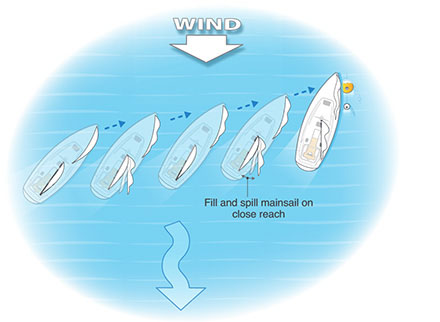
- Where should the pick-up point be relative to the vessel?
Many people pick up at the bow, but bear in mind once you are about a boat length from the buoy you can’t see it! Try an approach where you are bringing the buoy alongside at the shrouds or mid-ships. The vessel should be to leeward or down tide of the buoy so if you miss it, the elements will push you away from it rather than onto it. - How do I control the speed?
1. If using the mainsail: Use the fill and spill method (let the main out until it depowers and then before you lose all way, pull it back again in to maintain steerage). Although minimum boat speed for steerage still applies, it will be unlikely if you allow the yacht to stop you will get her moving again easily so try and keep her moving until you confident you will get to the buoy, this is a balancing act and the best part of sailing onto a buoy.
2. If using the headsail: De-power using the sheets as normal, however if you are still moving too quickly or for better control. Reduce the size of the sail until you are moving just slightly quicker than the speed of the tide, the ease and power up the sail using the sheets. As a safety point beware of the crew on the foredeck with flapping sheets and try to minimise this.
3. If using both sails: You would generally only select this if you couldn’t approach with one sail due to light airs, lots of tide or needing to punch through chop but NOT from downwind of the buoy as you won’t be able to depower the main. - Speed of approach
Minimum boat speed for steerage is the key. Use transits to the side to monitor your speed. Using the GPS or log for speed with a tide running is little or no use. A member of crew calling distance from the buoy can also be useful.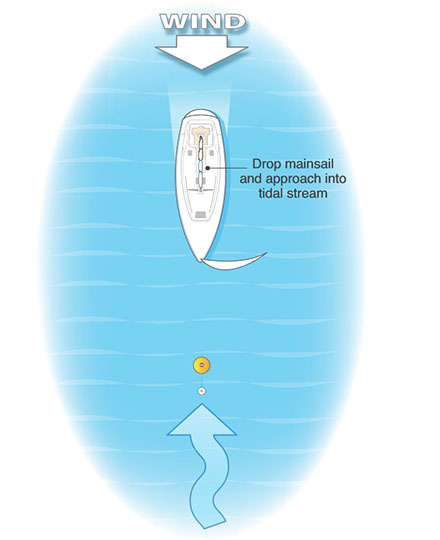
- What is your escape route?
Work out which way you would turn to get the yacht into safe water for the whole of the approach. - Lines rigged for the pick-up and boat hook ready
One end of the warp will need to be made off on a cleat via a fairlead, the other end will need to be with a crew member on the pre-planned side of the yacht. Make sure your crew know what to do with the line once attached to the buoy and how to secure it to the yacht ensuring it is through a fairlead or the bow roller and not tangled or over the guard wires. - To Lasso or not to lasso?
Normally you chose to sail onto a buoy to test your skills as a yachtsman, so if at all possible avoid lassoing. Slow the yacht and with a boat hook pick up the pickup buoy or with a crew member lying on the deck amidships, pass the line through the ring and take it forward. Although lassoing is not the preferred option sometimes in an emergency or if you are short-handed a lasso is the easiest option. Help crew rig the lasso and get them to practice throwing and securing it prior to the approach. If you are using a lasso have a second line ready to use so as soon as you are attached by the lasso, rigging a line to the correct ring or loop on the buoy and removing the lasso. Don’t stay on the lasso as it damages the buoy, creates chafe on your warp and can fall off of or get tangled around the buoy. - How will the crew tell you how far to the buoy, where it is and when it is secure?
Ensure you both understand the measurement i.e. feet or meters and that you can both see and hear each other. - Do the Crew understand what is expected of them?
Once you have your plan make sure your brief your crew and confirm they understand it. - If at first you don’t succeed!
If you miss the buoy first time don’t hurl abuse at the crew, use your escape route, have a think on why it didn’t work, re appraise, if it’s a new plan tell the crew, re-rig and go again. - What next?
Once secured to the buoy drop and secure the sails. Then determine how long you are going to stay. If more than two hours consider a second line though the buoy as a round turn and two half hitches to remove chafe and leave the other line slack as a safety line. Check that the depth will be sufficient for the time you are staying.
Execute
Once you have made you plan follow it. Constantly monitor your speed, depth, angle of approach and any hazards. Don’t be afraid to abort and change the plan.
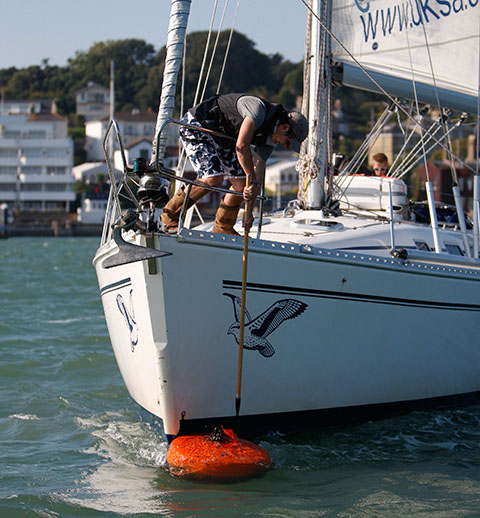
Review
Once secured to the buoy:
- Once secured to the buoy drop and secure the sails, then determine how long you are going to stay
- Check all lines are secured correctly to the deck and buoy.
- Remove as many chances of chafe as possible. If staying more than two hours consider a second line though the buoy such as a round turn and two half hitches to remove chafe and leave the other line slack as a safety line.
- Look at other vessels around you and if the tide or wind changes how will this affect you or them?
- If staying for a while, consider setting your anchor alarm.
- If staying overnight consider rigging an all-round white.
- Check the tide again to ensure there is enough water for your whole stay.
- Contact the owner of the buoy to pay.
- Review with the crew what went well and what, if anything, didn’t.
- Sit back and enjoy your new surroundings.
- And finally, as you have sailed on and it went so well, why not work out how you are going to sail off when it’s time to leave!
